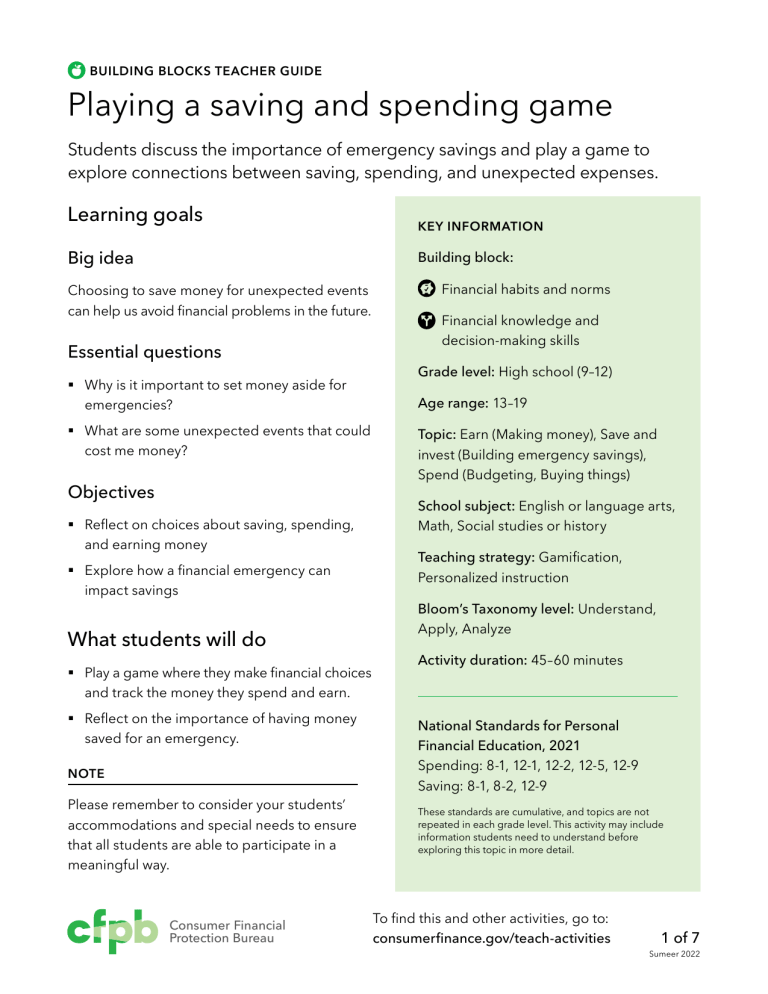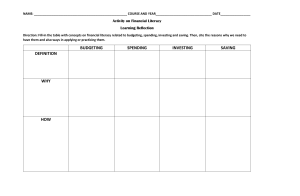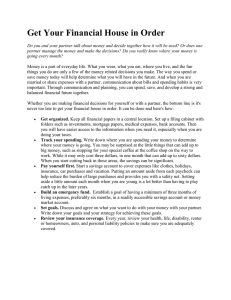
BUILDING BLOCKS TEACHER GUIDE Playing a saving and spending game Students discuss the importance of emergency savings and play a game to explore connections between saving, spending, and unexpected expenses. Learning goals Big idea KEY INFORMATION Building block: Choosing to save money for unexpected events can help us avoid financial problems in the future. Essential questions § Why is it important to set money aside for emergencies? § What are some unexpected events that could cost me money? Objectives § Reflect on choices about saving, spending, and earning money § Explore how a financial emergency can impact savings What students will do § Play a game where they make financial choices and track the money they spend and earn. § Reflect on the importance of having money saved for an emergency. NOTE Please remember to consider your students’ accommodations and special needs to ensure that all students are able to participate in a meaningful way. Consumer Financial Protection Bureau Financial habits and norms Financial knowledge and decision-making skills Grade level: High school (9–12) Age range: 13–19 Topic: Earn (Making money), Save and invest (Building emergency savings), Spend (Budgeting, Buying things) School subject: English or language arts, Math, Social studies or history Teaching strategy: Gamification, Personalized instruction Bloom’s Taxonomy level: Understand, Apply, Analyze Activity duration: 45–60 minutes National Standards for Personal Financial Education, 2021 Spending: 8-1, 12-1, 12-2, 12-5, 12-9 Saving: 8-1, 8-2, 12-9 These standards are cumulative, and topics are not repeated in each grade level. This activity may include information students need to understand before exploring this topic in more detail. To find this and other activities, go to: consumerfinance.gov/teach-activities 1 of 7 Sumeer 2022 Preparing for this activity □ While it’s not necessary, completing the “Bouncing ball budgets” activity first may make this one more meaningful. □ Print copies of all student materials for each student, or prepare for students to access them electronically. □ Print single-sided and cut out one set of the “Day-to-day money cards” for each group of students. What you’ll need THIS TEACHER GUIDE § Playing a saving and spending game (guide) cfpb_building_block_activities_playing-saving-spending-game_guide.pdf STUDENT MATERIALS § Playing a saving and spending game (worksheet) cfpb_building_block_activities_playing-saving-spending-game_worksheet.pdf § Day-to-day money cards (in this guide) Exploring key financial concepts TIP Everyone makes choices about saving, spending, and earning money. When you make those choices, it’s a good idea to think ahead about what you might need in the future. For example, you’ll probably experience some type of unexpected expense in your life. A car repair, a broken cell phone, or lost glasses can be both unplanned and expensive. If you don’t have money set aside for unexpected expenses, paying for them could be difficult to manage. Because products, terms, and laws related to saving money change, students should be encouraged to always look for the most up-to-date information. People also often have insurance to help them pay for unexpected expenses. But insurance may not cover all the unplanned expenses you may encounter. It’s a good idea to have an emergency fund set aside just in case you need it. Other types of savings include money you set aside for long-term goals, like a house, or short-term goals like a new sweater. Emergency funds are savings specifically for unexpected events that cost money. BUILDING BLOCKS TEACHER GUIDE Playing a saving and spending game 2 of 7 Summer 2022 Teaching this activity Whole-class introduction § Ask students to share an example of a time something unexpected happened that cost people money. ° Examples can include a global pandemic, a broken cell phone, or a car breaking down. § Share with students that people make their own choices about saving or spending money, but it’s a good idea to have some money set aside for emergencies. ° Tell students that the amount of money people need to have in an emergency fund depends on their situation. If they’re living paycheck to paycheck or don’t get paid the same amount each week or month, putting any money aside can feel difficult. But even a small amount can provide some financial security and will build up over time. § Explain that an emergency fund is different from regular savings, which may be focused on having money to meet short-term or long-term savings goals. ° An emergency fund is money that you set aside in a savings account that is specifically for unplanned expenses and financial emergencies. ° Regular savings often are used for short-term or long-term goals, which are specific purchases you plan to make. § Be sure students understand key vocabulary: ° Budget: A plan that outlines what money you expect to earn or receive (your income) and how you will save it or spend it (your expenses) for a given period of time; also called a spending plan. ° Emergency fund: A cash reserve that’s specifically set aside for unplanned expenses or financial emergencies. Some common examples include car repairs, home repairs, medical bills, or a loss of income. TIP Visit CFPB’s financial education glossary at consumerfinance.gov/ financial-education-glossary/. ° Financial emergencies: Expenses that come up unexpectedly, are very important, and need attention right away. ° Savings: Money you have set aside in a secure place, such as in a bank account, that you can use for future emergencies or to make specific purchases. BUILDING BLOCKS TEACHER GUIDE Playing a saving and spending game 3 of 7 Summer 2022 Group work § Tell students that they’ll play a game in which they’ll pick cards that feature dayto-day money choices and unexpected expenses. § Let them know that the card will have common scenarios that teenagers and young adults might encounter. § Divide students into groups of three or four. § Pass out one set of “Day-to-day money cards” to each group. ° Shuffle cards so that each set is in a different order. ° Tell the students to place the cards face down in front of them. § Distribute the “Playing a saving and spending game” worksheet to each student. ° Tell students that as they play the game, they should imagine what they would do in that situation. ° Students will complete the worksheet independently. § Tell students that they’ll each pretend to start out with $300. ° Half will be in their regular savings account and half will be in their emergency fund. § Students will take turns drawing a card from the top of the pile. ° They’ll read the scenario to their group, choose what to do, and add or subtract money from their accounts. ° Students will add $50 of income each time they draw a card. § When adding income, students can decide how they want to split that money between their accounts. § Note: For some cards, students may make a choice that says they won’t earn income that turn. When that happens, they don’t add $50 that turn. § To record their choices, students must: ° Decide which savings account to add or subtract money from. ° Decide if they need to transfer money between accounts (e.g., subtract from one or add to another). ° Calculate the new balance in their accounts. § The game ends after each student has had four turns, or all the cards have been drawn, whichever is first. BUILDING BLOCKS TEACHER GUIDE Playing a saving and spending game 4 of 7 Summer 2022 § Ask students to answer the reflection questions on the worksheet once the game ends. § Explain that there are no winners or losers in this game. Everyone makes spending and saving choices based on their own values and the rules they set for themselves. Wrap-up If time allows, ask volunteers to share their answers to the reflection questions. Suggested next steps Consider searching for other CFPB activities that address the topics of earning, including making money; saving and investing, including building emergency savings; or spending, including budgeting or buying things. Suggested activities include “Creating a savings first aid kit” and “Reflecting on what’s worth saving for.” Measuring student learning Students’ answers on their worksheets and during discussion can give you a sense of their understanding. Keep in mind that students’ answers may vary, as there may not be only one right answer. The important thing is for students to have reasonable justification for their answers. BUILDING BLOCKS TEACHER GUIDE Playing a saving and spending game 5 of 7 Summer 2022 Day-to-day money cards Print single-sided and cut out one set of cards for each group of students. Your friends are planning a night out at a nice restaurant. You weren’t planning to go because it wasn’t in your budget, but it seems fun. They said the cost would be around $35 per person. Will you go? While riding your bike home from work, a squirrel runs out in front of you, causing you to swerve into some bushes. Your bike, which you use to get to school and your job, needs $75 in repairs. You have two choices: 1. Repair the bike for $75. 2. Take the bus and subtract $20 each turn. What do you choose? While you were shopping, someone backed into your car and dented the door. Repairing the door will cost you $140. If you don’t repair the door, your car may rust and have more costly problems later. Will you repair the door? You accidentally dropped your cell phone and badly cracked the screen, and it’s almost unusable. You need your phone to get messages from your friends, family, and job. It’ll cost $100 to repair. Will you repair the screen? You want to buy gaming headphones to give as a birthday gift. After researching, you have two choices: You’re going on a trip with friends to another state. You’re deciding how to get there. You have two choices: 1. A pair with some reviews saying they can break easily. Cost: $25 1. Drive. Your share of gas and tolls will be $30, and you’ll have to miss a few days of work (so don’t add your $50 income this turn). 2. A pair with a reputation for being tough. Cost: $60. Which headphones do you buy? BUILDING BLOCKS TEACHER GUIDE 2. Fly. It will cost $180, but you won’t miss any work. What do you choose? Playing a saving and spending game 6 of 7 Summer 2022 Day-to-day money cards (continued) Print single-sided and cut out one set of cards for each group of students. While studying at a coffee shop, you bump your drink and it spills on your laptop. You need your laptop for school and work. Also, you’re in the middle of finishing an important assignment, and all the information is saved on that computer. You have two choices: It’s spring break. You have two choices for how you’ll spend your week: 1. House-sit for neighbors. Feed the pets, water plants, collect mail, and watch the house. Make $200. 2. Pay $50 to retrieve the file and wait to repair your computer later. 2. Go on vacation with your friend’s family. Spend $150 and lose out on income that week (so don’t add your $50 income this turn). What do you choose? What do you choose? 1. Pay $150 to repair the damage. While playing ball outside, you accidentally broke a neighbor’s window. They’ve asked you to pay $250 to cover their homeowner’s insurance deductible. Will you pay for the window? You go shopping with your friends. They all want to get matching sneakers that cost $85. Will you buy the sneakers? BUILDING BLOCKS TEACHER GUIDE While cleaning your room, you find $40 in a birthday card you received a couple of months ago. You have two choices: 1. Spend it on something you really want. 2. Deposit it into your emergency savings fund. What do you choose? You’ve been invited to perform with your high school at a national event. Most of the expenses are being covered, but you must pay $50 for the transportation. Will you go on the trip? Playing a saving and spending game 7 of 7 Summer 2022

